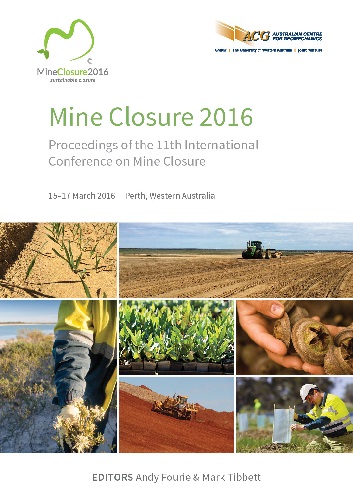Developing Anglo American’s integrated closure planning system requires people, process and technology working together

|
Authors: Grant, CD; Lacy, HWB |
DOI https://doi.org/10.36487/ACG_rep/1608_43_Grant
Cite As:
Grant, CD & Lacy, HWB 2016, 'Developing Anglo American’s integrated closure planning system requires people, process and technology working together', in AB Fourie & M Tibbett (eds), Mine Closure 2016: Proceedings of the 11th International Conference on Mine Closure, Australian Centre for Geomechanics, Perth, pp. 581-594, https://doi.org/10.36487/ACG_rep/1608_43_Grant
Abstract:
Integrating closure planning with other mine-planning processes is not a new idea. While most would agree on the benefits of such an approach, examples where the potential is realised remain the exception. Anglo American commenced the development of an Integrated Closure Planning System (ICPS) with the aim to provide a consistent approach over the lifecycle of projects for the reporting and management of long-term liabilities, to achieve their goal of ensuring that they leave a positive and sustainable legacy for their host communities after their operations have closed. We propose that to achieve this objective requires focus on people, process and technology. The elements of the ICPS are: planning (e.g. life-of-mine (LOM), closure, short/medium term mine, rehabilitation), financials (e.g. premature and LOM closure liability, operational expenditure, guarantees), systems (e.g. closure toolboxes, Geographic Information Systems, Environmental Management Systems) and requirements (e.g. internal/external standards, policy, regulation). A multi disciplinary team comprising mine closure, mining engineering/planning, technology and business process experts from Anglo and MWH was formed to develop the ICPS. The process involved identifying the current state of processes and systems, the target state of a fully integrated process, developing a maturity scorecard and identifying potential technology solutions that may assist in realising value at the operational level. In defining the current condition across the operations it became evident that roles and responsibilities were not clear across the organisation, both the LOM and immediate mine planning processes had no clear platform or process to facilitate closure planning interactions, and that over 40 software solutions were being used across Anglo's business units. This finding reinforced the importance and emphasised the critical nature of the ‘people, process and technology’ elements. Through application of a balanced scorecard, and Anglo’s internal assessment of 53 Anglo operations across the globe, potential pilot mine sites were identified with low, moderate and high levels of ICPS maturity, with associated high closure risk or opportunities. Project implementation plans were developed to increase the ICPS maturity at the pilot sites to the required level that will maximise value realisation or minimise value destruction from a mine closure perspective. The paper presents the finding of the evaluation work conducted, will discuss the challenges and process applied in the development of the implementation plans that advance development of Anglo's ICPS.
Keywords: integrated planning, mine closure process, software platform
References:
Australian Government 2006, ‘Mine Closure and Completion’, Leading Practice Sustainable Development Program for the Mining Industry, Department of Industry Tourism and Resources, Commonwealth of Australia, Canberra.
Botha, PR 2013, Anglo American mine closure toolbox, version 2, Anglo Operations Pty Ltd, London.
Environment Australia 2002, ‘Mine decommissioning’, Best practice environmental management in mining series, Environment Australia, Canberra.
Grant, CD 2006, ‘Decommissioning Alcoa’s first bauxite mine in the Jarrah Forest of Western Australia: Cradle to grave’, in A Fourie & M Tibbett (eds), Proceedings First International Seminar on Mine Closure, Australian Centre for Geomechanics, Perth, pp. 287–297.
Grant, CD & Botha PR 2015, ‘Integrated closure planning: case studies on changing operational strategies to reduce closure liabilities’, in A Fourie, M Tibbett, L Sawatsky & D van Zyl (eds), Proceedings of the Tenth International Seminar on Mine Closure, Keynotes and Plenaries, InfoMine.
ICMM (International Council on Mining and Metals) 2006, Integrated mine closure, ICMM, London.
ICMM (International Council on Mining and Metals) 2008, Planning for integrated mine closure: toolkit, ICMM, London.
Lacy, H 2000, ‘Planning the Process of Closure “Close As You Go”’, in Proceedings Planning for Mine Closure – An Operator’s Guide, Australian Centre for Geomechanics Seminar No. 2009, Perth.
Lacy, HWB & Bennett, KE 2015, Updating Australia’s leading practice sustainable development (LPSD) mine closure handbook for 2015: Closing the gaps and understanding the mineral resource legacy, in A Fourie, M Tibbett, L Sawatsky & D van Zyl (eds), Proceedings of the Tenth International Seminar on Mine Closure, Keynotes and Plenaries, InfoMine.
MWH 2015, Integrating Systems to Optimise Mine Closure Planning: Solution Analysis, Internal Document Anglo American May 2015.
© Copyright 2025, Australian Centre for Geomechanics (ACG), The University of Western Australia. All rights reserved.
View copyright/legal information
Please direct any queries or error reports to repository-acg@uwa.edu.au
View copyright/legal information
Please direct any queries or error reports to repository-acg@uwa.edu.au